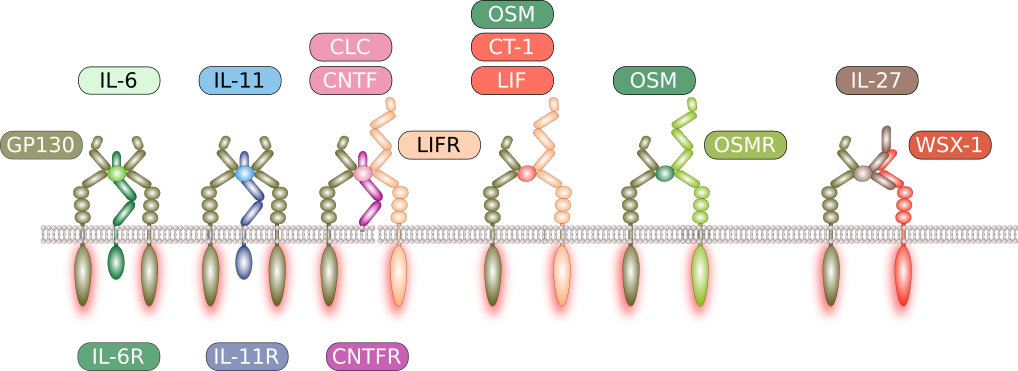Signal molecules
Cytokines
The family of IL-6 cytokines has eleven members and pleiotropic functions within the body. All family members share the same signal transducing subunit GP130 (Figure 2). In the recent years, gain- and loss-of-function mutations have been discovered in different pathologies, including liver cancer. On the basis of these mutations, we’re trying to understand how GP130 signals emerge from different subcellular localisations (Figure 3 a), how they differ in signal quality and how cytokine selectivity of GP130 is achieved at a molecular level. IL-6 family cytokines can have diverse biological outcomes depending on the cell type of the receiver cell (Figure 3 b). Current mouse models were unable to dissect cell type-specific cytokine effects. By using a novel in vivo mouse model we’re now able to analyse cell type-specific effect of GP130 signals to a certain biological outcome in different pathological settings including primary tumour growth and metastasis. Based on our findings we aim to interfere with GP130 signalling in a cell type-specific manner.

Major contributions:
- Functional and structural analysis of cytokine-selective IL6ST defects that cause recessive hyper-IgE syndrome. Chen YH, Zastrow DB, Metcalfe RD, Gartner L, Krause F, …, Schmidt-Arras D*, Laurence A*, Bernstein JA*, Griffin MDW*, Uhlig HH*. J Allergy Clin Immunol. (2021), epub ahead of print, *shared authorship
- Cell-autonomous hepatoellular GP130 signalling alone is sufficient to induce robust innate immune response in mice. Schumacher N, Müller M, …, Schmidt-Arras D. J Hepatol (2021),74(2):407-418.
- A variant in IL6ST with a selective IL-11 signaling defect in human and mouse. Schwerd T*, Krause F*, …, Wilkie AOM*, Schmidt-Arras D*, Uhlig HH*. Bone Res. (2020), 8:24. *shared authorship
- IL-6 trans-signalling is essential for the development of hepatocellular carcinoma in mice. Bergmann, J.; Müller, M..;… and Schmidt-Arras, D. (2017). , Hepatology 65(1):89-103
- Oncogenic deletion mutants of gp130 signal from intracellular compartments.Schmidt-Arras, D.* et al. (2014), J Cell Sci 127 : 341-353. *corresponding author




